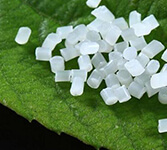Growing applications of PLA in various end-use industries to boost the market growth

18 Mar
2016
Polylactic acid (PLA) is commercially available and bio-based and bio-degradable thermoplastic aliphatic polymer, produced by processes of fermentation and polymerization, using starchy grain raw materials such as corn, potatoes, wheat, beets. The bio-based polymer exhibits high mechanical strength and low toxicity and various manufactures use innovative polymerization techniques to alter the characteristics of the compound which give rise to new applications like bio-based plastics. Furthermore, good barrier properties and ability to blend well with other polymers using technique such as copolymerization have expanded its applications for packaging food and beverages. Emerging high value applications across a range of end-user industries such as textiles, constructions and automotive would further boost the market growth across regions.
Variation in the polymer architecture of the PLA need developing innovative compatibility features between the material and other polymers. Industrial manufacturers focus on developing universal expertise on combining various materials like cellulose, starch and many other bio-based materials to change the polymer architecture, resulting in a range of end products. Universalization of combination techniques enable manufacturers make new combinations of materials by processing the compound in standard equipment such as injection mold machines and extruders. This would further decrease molding defects like discoloration and strong odor in the finally produced products. Prominent companies involved in manufacturing PLA strive to reduce significantly net greenhouse gas emissions of commercially produced acid.
Increasing consumer awareness on sustainable and green products, favorable government incentives and wide availability of raw materials, increasing applications among end-use industries are the key factors boosting the market growth. The World Polylactic Acid Market was worth $305.6 million in 2014 and is expected to grow at a CAGR of 15.9% during 2015-2020 forecast period.
However, PLA market witnesses significant competitive against synthetic plastics in terms of cost. Furthermore, alternative renewable packaging materials such as Bio- PE, PHA, and Bio-PET may hinder the growth of the market.
North America was the largest producer of PLA and accounted for around 49.6% of the global consumption in 2014. As per the report, North American region would maintain its dominance along the forecast period owing to large production capacity, presence of large feedstock as raw materials, and supportive government regulations.
Various industry players are making huge investments in setting up bioplastic PLA plants. Corbion, a Netherland based company, has planned to aiming to open new polylactic acid (PLA) plant in Rayong Province of Thailand in 2018. Driven by huge strong customer interest in PLA, the global company has already commenced with pre-engineering in 2015 and aims to equip the plant with an annual capacity of 75,000 tonne per annum (tpa). Various other companies are explore strategic opportunities in PLA market by making huge investments on R&D activities related to biotechnology arena.
Prominent market players extensively profiled in this report include Synbra, Corbion Purac, NatureWorks LLC, Hisun Biomaterials, Nantong Jiuding Biological EngineeringCo. Ltd, and Futerro and others.

Akhilesh Prabhugaonkar
Author's Bio- Akhilesh Prabhugaonkar holds a bachelor’s degree in Electronics Engineering from the reputed Vishwakarma Institute of Technology. He has a special interest in the fields of forensics, world history, international relations and foreign policy, sports, agriculture, astronomy, security, and oceanography. An ardent bibliophile and melophile, Akhilesh loves to write on topics of his interest and various other societal issues. This love for writing made him enter the professional world of content writing and pursue his career in this direction.
Avenue: Entire Library membership of Allied Market Research Reports at your disposal
- Avenue is an innovative subscription-based online report database.
- Avail an online access to the entire library of syndicated reports on more than 2,000 niche industries and company profiles on more than 12,000 firms across 11 domains.
- A cost-effective model tailored for entrepreneurs, investors, and students & researchers at universities.
- Request customizations, suggest new reports, and avail analyst support as per your requirements.
- Get an access to the library of reports at any time from any device and anywhere.
Related Post
-
How are Submarine Cables Transforming Global Connectivity with Enhanced User Experience?
-
Endoscopy Procedures: Transformations in Techniques and Applications
-
AI-Powered Video Analytics: How the Product Actually Works for enterprises
-
Painting Robots: Transforming Precision Coating and Creative Applications
-
Innovations in Pharmacovigilance Systems Advancing Patient Safety
-
Understanding Edge Security: Keeping Data Safe Near the Source
-
Exploring the Use and Advancements of 3D Laser Scanners in Professional Applications
-
Reinforcing Industrial Controls with Smarter Tools and Training








